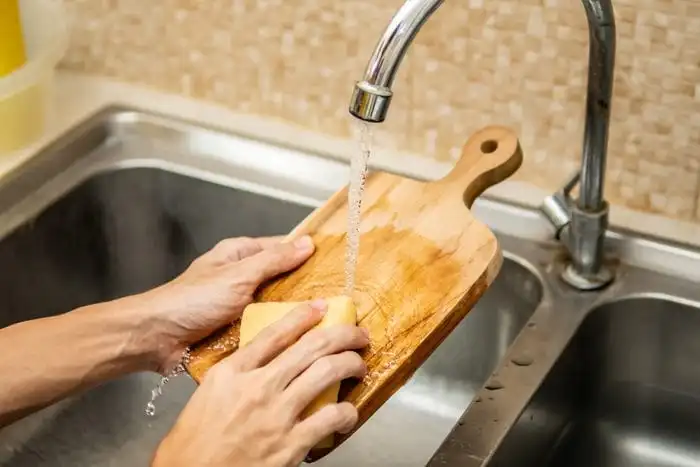Bamboo Cutting boards are very popular because of their strength, sustainability as well as appealing design. It is important to know how to properly clean and maintain your bamboo cutting board in order to ensure its durability and hygienic use. This article will guide you step-by-step through cleaning, oiling as well as maintenance of your bamboo cutting board so that it lasts for years to come. Bamboo cutting board care is crucial.
Understanding Bamboo Cutting Boards

Bamboo Cutting board is a great option for kitchen use because of its durability and resistance to moisture. It is more resistant to knife marks and tougher than the majority of hardwoods which helps maintain a smooth surface.
Although using bamboo cutting boards is typically safe but there are a few safety considerations that must be taken. To reduce the chance of bacterial infection, avoid cutting raw meat directly on a bamboo cutting board. If bamboo cutting boards are exposed to an excessive amount of moisture or heat, they can be more prone to warping or cracking. Cleaning bamboo cutting boards is crucial.
Cleaning and Maintenance
It is important to regularly clean bamboo cutting boards to avoid the accumulation of bacteria and food particles. You can lower the chance of cross-contamination and improve the security of your food preparation by keeping a clean surface.
The bamboo cutting board should first be rinsed with warm water. Use a soft brush or sponge to apply a tiny amount of mild dish soap and scrape the surface. Because they can harm the bamboo. So stay away from using harsh chemicals or abrasive cleaning.
The board may dry out or distort if harsh detergents or abrasive cleaners remove the bamboo natural oils. To keep the cutting board’s quality, use gentle cleaning products only.
Use a soft brush or sponge to gently scrape any food residue off the cutting board surface. Make sure to thoroughly clean by paying attention to grooves and crevices.
Also, Use a fresh towel to completely dry the bamboo cutting board after cleaning it. To stop the growth of mold or mildew, make sure there is no moisture left on the surface.
Furthermore, The bamboo cutting board should be kept in a dry, well-ventilated place. It can bend or crack if it is placed too close to a heat source or in direct sunlight.
Make a mixture of water and lemon juice to remove tough stains from your bamboo cutting board. Scrub the discolored areas gently after applying the paste. Dry off the board after a thorough rinse.
To remove unwanted odors from a bamboo cutting board, wipe the surface with a cloth soaked in white vinegar or lemon juice. The natural acidity will help neutralize odors.
Oiling a Bamboo Cutting Board
Oiling a bamboo cutting board is crucial in order to maintain its moisture as well as to protect it from drying out or cracking over time. As a barrier, the oil stops liquids and food particles from penetrating the board.
It is important to choose food-safe oils that would not go rancid or change the flavor of your food when oiling a bamboo cutting board. Mineral oil, coconut oil, and food-grade linseed oil are some suggested substitutes.
Before adding oil, make sure the bamboo cutting board is clean and dry. Clear the surface of any traces of food.
Apply a thin layer of oil to the cutting board surface using a clean cloth or paper towel. Be sure to touch every edge and corner.
Also, Let the oil penetrate the bamboo for a few hours or overnight. This allows oil to seep into the wood fibers, nourishing and protecting the board.
The frequency of oiling depends on the level of use. As a general rule, it is recommended to oil your bamboo cutting board every few months or when it starts to appear dry. Regularly inspect the board for any signs of drying or cracking.
To treat bamboo cutting boards, use beeswax or coconut oil.. Apply a small amount and rub it on the surface, allowing it to absorb. This provides a natural protective layer.
Food-grade mineral oil is the best oil for bamboo cutting boards. It helps prevent water absorption and keeps the bamboo moisturized.
Additional Care Tips on How To Clean Your Bamboo Cutting Board
To prevent warping or cracking, avoid leaving your bamboo cutting board in standing water or excessively wet conditions. Wipe off any spills promptly and allow the board to dry completely before storage.
Also, To minimize knife marks and scratches on your bamboo cutting board, use a wooden or plastic cutting board for heavy chopping or cutting. Reserve the bamboo board for lighter tasks like slicing fruits and vegetables.
Additionally, Periodically check the sealing on your bamboo cutting board. If the board appears dry or shows signs of wear, consider resealing it with food-safe mineral oil or wax to maintain its quality.
Furthermore, It is not good to dish wash bamboo cutting boards. The high heat and prolonged exposure to water can cause the board to warp or crack. Hand washing is the best method to preserve board quality.
Oiling a bamboo cutting board is essential to prevent them from drying out and developing cracks. Regular oiling helps maintain the board’s moisture content as well as prolong its lifespan.
FAQs: How To Clean Your Bamboo Cutting Board
How to treat bamboo cutting boards?
To treat bamboo cutting boards, apply food-grade mineral oil or beeswax to protect and moisturize the surface.
How to care for bamboo cutting boards?
Care for the bamboo cutting board by regularly cleaning it with mild soap along with warm water, drying it thoroughly as well as oiling it regularly to maintain its quality.
Is bamboo cutting boards dishwasher safe?
Avoid putting bamboo cutting boards in the dishwasher to prevent warping or splitting from the high heat and prolonged exposure to water.Read more
Do you oil bamboo cutting boards?
Yes, oiling bamboo cutting boards ensure their longevity as well as functionality by helping to prevent drying & cracking.
How to seal a wooden cutting board?
Apply food-grade mineral oil or a combination of mineral oil and beeswax on a wooden cutting board to seal it. Let it sit overnight before wiping off the extra.




